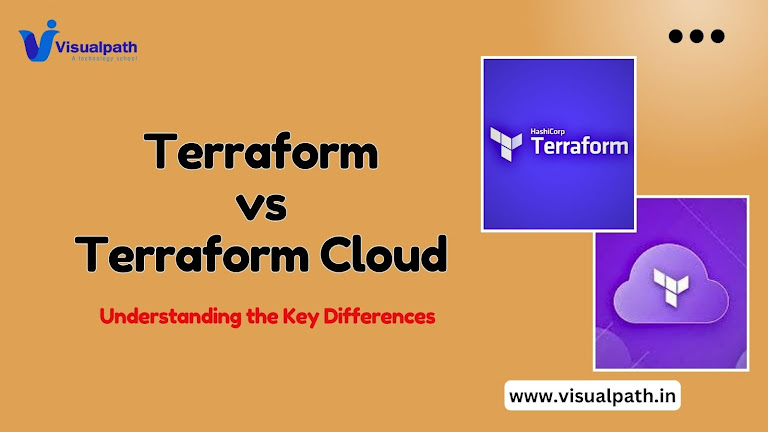- Get link
- X
- Other Apps
- Get link
- X
- Other Apps
Terraform and Terraform Cloud are both key components in infrastructure as code (IaC) practices, but they serve different purposes and have distinct features. Understanding the differences between the two can help in choosing the right tool for your DevOps or cloud infrastructure needs. Here’s an in-depth comparison: Terraform Automation Online Training
Terraform
Terraform is an open-source tool developed by HashiCorp that
allows users to define and provision data center infrastructure using a
high-level configuration language called HashiCorp Configuration Language
(HCL), or optionally JSON.
Core Features of Terraform:
1. Declarative Language: Terraform uses a declarative
approach, where you define the desired state of your infrastructure, and
Terraform figures out the steps to achieve that state. This makes it easier to
manage infrastructure changes and avoid human errors.
2. Provider Ecosystem: Terraform supports a vast array of
cloud providers (AWS, Azure, GCP, etc.) as well as other service providers
(Kubernetes, GitHub, etc.), making it a versatile tool for multi-cloud and
hybrid cloud environments. Terraform
Automation in Azure Online Training
3. State Management: Terraform maintains a state file
that tracks the current state of the infrastructure. This state file is
critical for determining what changes need to be made to reach the desired
state. By default, the state is stored locally, but it can be stored remotely
in a secure storage like AWS S3, Azure Blob Storage, or GCS.
4. Plan and Apply: Terraform provides a terraform plan
command, which allows you to see what changes will be made before applying
them. This ensures that you have a clear understanding of the impact of changes
before they are executed. The terraform applies command and then makes those
changes to the infrastructure.
5. Modularity and Reusability: Terraform allows you to create
reusable modules, which are self-contained packages of Terraform
configurations. This promotes the reuse of code across different projects
and environments, improving consistency and reducing duplication.
Terraform Cloud
Terraform Cloud is a managed service provided by HashiCorp
that extends Terraform with additional features and benefits, particularly
around collaboration, automation, and security.
Core Features of Terraform Cloud:
1. Collaboration and Workflow
Management:
Terraform Cloud provides a collaborative environment where teams can work
together on infrastructure as code. It supports features like remote runs,
team-based permissions, and access controls, making it easier for teams to
collaborate on infrastructure changes.
2. Remote State Management: Terraform
Cloud automatically manages and stores Terraform state files securely. This
eliminates the need to manually configure remote state storage and ensures that
state files are always up-to-date and consistent across your team.
3. Automated Workflows: With Terraform Cloud, you can
automate Terraform runs, including planning and applying operations, through
its workspace-based system. It integrates seamlessly with version control
systems like GitHub, GitLab, and Bitbucket, enabling automatic infrastructure
deployments upon changes in code repositories. Terraform Online
Training
4. Cost Estimation: Terraform Cloud includes a cost
estimation feature that helps you understand the potential costs associated
with your infrastructure changes before applying them. This is particularly
useful for budgeting and cost management in cloud environments.
5. Policy as Code: Terraform Cloud offers Sentinel, a
policy-as-code framework that allows you to define and enforce policies around
your infrastructure deployments. This helps ensure that all changes comply with
organizational policies and regulatory requirements.
6. Enhanced Security and Compliance: Terraform Cloud provides enhanced
security features such as single sign-on (SSO), role-based access control
(RBAC), and audit logging. This makes it a more secure choice for enterprise
environments where compliance and security are critical.
Key Differences:
- Scope: Terraform is primarily a tool
for defining and provisioning infrastructure, while Terraform
Cloud is a platform for managing Terraform deployments with additional
collaboration, automation, and security features.
- State
Management:
Terraform relies on manually configured remote state storage, whereas
Terraform Cloud automatically manages state files securely.
- Collaboration: Terraform Cloud is designed for
teams and offers collaborative features unavailable in the standalone
Terraform tool.
- Automation: Terraform Cloud provides
built-in CI/CD capabilities, allowing for automated infrastructure
deployments, which is beyond the scope of Terraform. Terraform Automation in Azure Cloud Training
Conclusion:
Terraform and Terraform Cloud are complementary tools in the
infrastructure as a code ecosystem. While Terraform is powerful on its own,
Terraform Cloud adds significant value in team-based environments where
collaboration, automation, and security are essential. Choosing between the two
depends on the specific needs of your organization and the complexity of your
infrastructure.
Visualpath
is the Best Software Online Training Institute in Hyderabad. Avail complete Terraform Automation in Azure Online Training worldwide.
You will get the best course at an affordable cost.
Attend
Free Demo
Call on - +91-9989971070.
WhatsApp: https://www.whatsapp.com/catalog/919989971070
Blog Visit: https://visualpathblogs.com/
Visit
https://www.visualpath.in/terraform-online-training-in-hyderabad.html
Terraform Automation in Azure CloudTraining
Terraform Automation in Azure Online Training
Terraform Automation Online Training
Terraform Automation Training
Terraform Online Training Courses
- Get link
- X
- Other Apps

Comments
Post a Comment